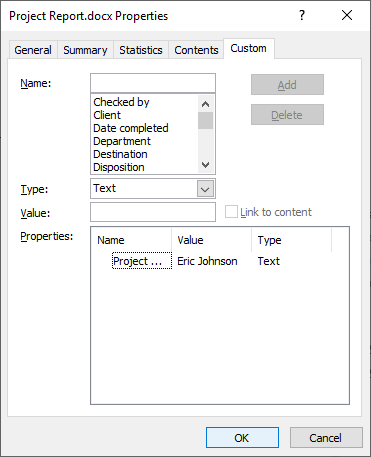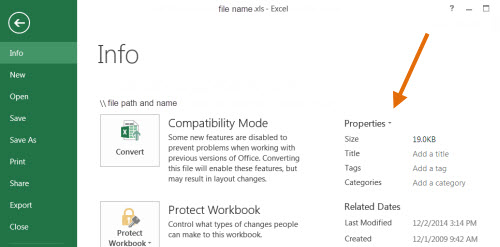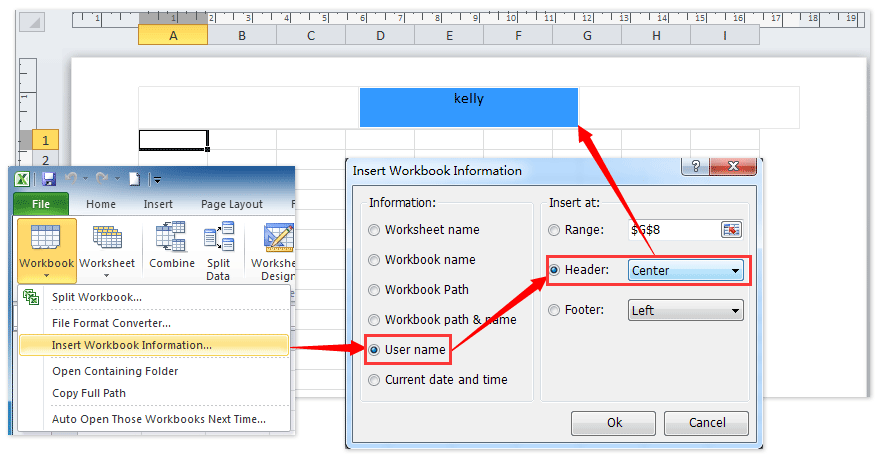- Add Document Properties In Excel 2016
- Add Custom Document Property Excel
- What Tab Enables You To Add Document Properties In Excel
- How Do You Add Document Properties In Excel
- How To Add Document Properties In Excel 2016
Double-click the header or footer. Select Document Info, and choose the information you want. Note: Select Document Property to select additional information, such as Title, Company, or Subject. Select Close Header and Footer or press Esc to exit. Jan 08, 2019 If you add a custom document property to the DocumentProperties collection that's linked to a given value in an Office document, you must save the document to see the change to the DocumentProperty object. This example, which is designed to run in Word, adds three custom document properties to the DocumentProperties collection. Open your Excel file in Excel and click on “File” in the top-left corner of the window. Alternatively press Alt and then F on the keyboard. Click on “Info” on the left-hand side. Excel shows a good summary of the document properties saved to this file. If you want to see (a few) more details, click on “Show All Properties”.
Adding the Share Workbook and Track Changes Legacy Features in Excel 2016
With a software update to certain versions of Excel in late summer 2017, Microsoft bought in a new co-authoring feature to support sharing of workbooks online. At the same time, Microsoft designated the Share Workbook and Track Changes as legacy features and removed them from the Excel ribbon. These legacy features are still available to users who want to add them to their version of Excel.
The Share Workbook and Track Changes features are useful for sharing a workbook on a network drive rather than online. You may add them to the Quick Access Toolbar, or you may add them to the Excel ribbon by creating a new group and adding them to the new group.
Add the Share Workbook and Track Changes Legacy Features to the Quick Access Toolbar
- Click the Customize Quick Access Toolbar button at the right of the Quick Access Toolbar and then click the More Commands option at the drop-down list.
- Verify that the QuickAccessToolbar option is selected in the left panel at the Excel Options dialog box, click the Choosecommandsfrom option box arrow in the right panel, and then click either the CommandsNotintheRibbon option or AllCommands option at the drop-down list.
- Scroll down the Commands Not in the Ribbon or All Commands list box and then double-click the Share Workbook (Legacy) option. The Share Workbook (Legacy) command is added to the Customize Quick Access Toolbar list box.
- Scroll down the Commands Not in the Ribbon or All Commands list box and then double-click the Track Changes (Legacy) option. The Track Changes (Legacy) command is added to the Customize Quick Access Toolbar list box.
- Click the OK button.
- The Share Workbook (Legacy) and Track Changes (Legacy) commands are added to the right side of the Quick Access Toolbar.
Add the Share Workbook and Track Changes Legacy Features to the Ribbon
- Click the File tab.
- Click the Options option in the left panel at the backstage area.
- Click the Customize Ribbon option in the left panel at the Excel Options dialog box.
- Click the Review option in the Main Tabs list box in the right panel.
- Click the New Group button.
- Verify that the New Group (Custom) option is selected in the Main Tabs list box and then click the Rename button.
- With the text selected in the Display name text box at the Rename dialog box, type Collaborate. (Do not type the period.)
- Click the OK button.
- Click the Choosecommandsfrom option box arrow in the right panel at the Excel Options dialog box and then click either the CommandsNotintheRibbon option or AllCommands option at the drop-down list.
- Scroll down the Commands Not in the Ribbon or All Commands list box and then double-click the Share Workbook (Legacy) option. The Share Workbook (Legacy) command is added to the Customize Quick Access Toolbar list box.
- Scroll down the Commands Not in the Ribbon or All Commands list box and then double-click the Track Changes (Legacy) option. The Track Changes (Legacy) command is added to the Customize Quick Access Toolbar list box.
- Click the OK button.
- The Share Workbook (Legacy) and Track Changes (Legacy) commands are added in the new group Collaborate on the Review tab of the Excel ribbon.
Add Document Properties In Excel 2016
Affected Courseware
Advanced Microsoft® Excel® 2016, Chapter 14, Sections 14.3 and 14.4 (textbook pages 685–693)
Benchmark series, Microsoft® Excel® 2016, Level 2, Chapter 6 (textbook pages 147–154)
Popular Posts
Contact
Courseware
Microsoft Office Application
Archives
Document properties are also referred to as metadata. They include information related documents such as title, author name, subject, and keywords to identify the document's topic.
In Microsoft Word, there are the following four types of document properties -
- Standard properties
- Automatically updated properties
- Custom properties
- Document library properties
Create a custom property for the current Word document

In Microsoft Word 2010, follow the below steps to create a custom property for current Word document -
Step 1: Open the new or an existing Word document.
Step 2: Click on the File tab at the top left corner of the document.
Step 3: A list of file options will appear on the screen with the selected Info tab.
Step 4: Click on the drop-down menu associated with the Properties. Select Advanced Properties from the Properties drop-down menu.
Step 5: A current document Properties dialog box will appear on the screen in which click on the Custom tab.
Step 6: A custom tab will open with the following text fields -
Name: Enter the Custom property name in the Name text field or you can also select name from the Name list.
Add Custom Document Property Excel
Type: Select Type from the Type list
Value: Type Value for the custom property
What Tab Enables You To Add Document Properties In Excel
Once you enter Name, Type, and Value in the custom tab, click on the OK button at the bottom of the screen.
Now, you can see that your desired custom properties are added to the Properties section.

Set Advanced document properties in Word document
Follow the below-mentioned steps to set advanced document properties in Word document -
Step 1: Open the new or an existing Word document where you want to set advanced document properties.
Step 2: Go to the File tab on the Ribbon. A list of File options will appear with the selected Info option.
Step 3: Click on the drop-down menu associated with the Properties and select Advanced Properties on the right side of the Info screen.
How Do You Add Document Properties In Excel
Step 4: An Advanced Properties dialog box will appear on the screen in which click on the Summary tab.
Step 4: A Summary dialog box will appear on the screen in which enter the information related to your current documents such as Title, Author, Subject, Company name, Keywords, and more.
Once you fill all necessary information in the Summary dialog box, click on the OK button, as shown in the screenshot below.

Now, when you open the Info Tab, the information you entered in the summary dialog box will appear on the screen.

Show advanced document properties to the current document
Microsoft Word allows you to show (display) and edit the advanced document properties at the top of the current document.
Follow the below instruction to see the advanced document properties -
1. Open the Word document where you set the advanced document properties.
2. Go the File tab on the Ribbon, a list of options will appear on the screen with the selected Info tab.
3. Click on the Properties drop-down menu and click on the Show Document Panel option on the Right corner of the Info screen.

4. The screenshot below shows that Document Properties option will automatically appear at the top of the current Word document.
Note: Using the Document Properties panel, you can also edit the entered information.
How To Add Document Properties In Excel 2016
To close the Document Properties panel, click on the cross (×) button in the upper right corner of the Document Properties panel.